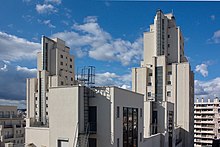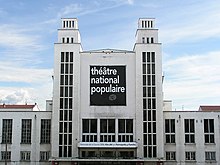Môrice Leroux
Môrice Leroux (born October 15, 1896 in Domfront , France - November 1, 1963 in Paris ) was a French architect .
life and work
Môrice Leroux was a self-taught architect . His work is largely unknown. In 1910 he had to quit school in order to earn a living. He worked as an employee for an insurance company and was responsible for buildings. Here he gained his first building experience. From 1914 to 1918 he served as a soldier in the First World War . After the war, he gave up his job with Mutuelle du Mans insurance company to take part in the reconstruction of the war-torn eastern and northern regions of France.
Until 1922 he worked as a draftsman and building cost calculator for the architect Girard in Beauvais ; until 1928 he worked for the architect of the city of Paris and the Seine department , Paul Lebret (1875-1933), who had studied architecture with Tony Garnier at the École des Beaux-Arts de Paris. In 1928 Leroux won the competition for the Palace of Labor in Villeurbanne . There he built the Palace of Labor, which, together with the town hall designed by his colleague Robert Giroud, forms the center of the new city center, which was built according to his plans from 1927 to 1931 and which today serves as a theater.
In 1942 Leroux became a member of the French Chamber of Architects. From 1948 to 1960 he participated in the reconstruction of the war-torn Caen .
reception
Using the example of Stalinallee in East Berlin, Thilo Hilpert refers to the importance of the city center of Villeurbanne for modern urban planning in Germany. Jean-Francois Loiseau documents the city center of Villeurbanne in a video.
Individual evidence
- ↑ Morice Leroux (1896-1963). Collège des Gratte-Ciel Môrice Leroux, accessed on April 28, 2019 (French).
- ↑ Emmauelle Gallo: La réception et le quartier des gratte-ciel, center de Villeurbanne, ou pourquoi of gratte-ciel à Villeurbanne en 1932? 2005, accessed April 27, 2019 (French).
- ↑ archiwebture: Fund Lebret, Paul (1875-1933). 318 AA. In: archiwebture. archiwebture, accessed on May 13, 2019 (French).
- ^ Sylvestre, Jules, 1859-1936 (photographe): Projet des Gratte-ciel de Villeurbanne: maquette (Môrice ... précédente / 79suivante. In: Photographes en Rhône des Alpes. Bibliothèque municipale de Lyon, accessed on April 28, 2019 ( French).
- ^ Thilo Hilpert: Hermann Henselmann, the architect of the Stalinallee . In: Century of Modernity . Springer Vieweg, Wiesbaden 2015, ISBN 978-3-658-07042-7 , pp. 231 .
- ^ Jean-Francois Loiseau: Le quartier des Gratte-ciel (Villeurbanne 1931-1934) - Morice Leroux - Utopies réalisées (episode 2). youtube, August 4, 2013, accessed on April 27, 2019 (French).
| personal data | |
|---|---|
| SURNAME | Leroux, Môrice |
| BRIEF DESCRIPTION | French architect |
| DATE OF BIRTH | October 15, 1896 |
| PLACE OF BIRTH | Domfront , France |
| DATE OF DEATH | November 1, 1963 |
| Place of death | Paris |


